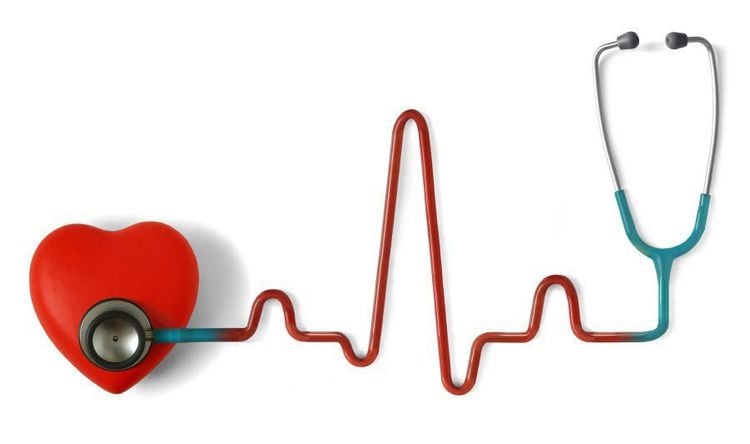This is an automatically translated article.
The article is professionally consulted by Master, Doctor Vu Thi Tuyet Mai - Cardiovascular Center - Vinmec Central Park International General Hospital.
In clinical practice of cardiac examination, auscultation is a very important operation. Auscultation provides physicians with valuable information to aid in the accurate diagnosis of cardiac conditions.
1. Method of auscultation and location of auscultation
1.1 Methods of auscultation There are two methods of listening to the heart: direct listening and listening with a stethoscope.Listen directly: Listen with the right ear, place the ear against a thin towel spread over the patient's chest. Currently, this method is not applied because it is inconvenient to listen to the armpit area, especially for female patients; Indirect listening: Listening with a stethoscope worn in two ears, being widely applied today. The stethoscope consists of 3 parts: the stethoscope wire (to hear clearly, it should be no more than 30cm in length, 3-4cm in diameter, thick enough to prevent noise), the membrane part (transmits sounds with frequencies > 300Hz ) and the bell conducts sounds with frequencies of 30 - 150Hz. 1.2 How to listen to the heart The patient should be heard in the supine position, in the left side or sitting position.
1.3 Auscultation position Auscultate the heart at the following positions:
Mitral valve: At the apex of the heart in the 3rd intercostal space or 5th rib above the left breast line. When sick, the apex of the heart may drop low or to the left, the doctor needs to listen to the new location of the apex; Tricuspid valve: Located on the right 6th costal cartilage; Aortic valve foci: One in the 2nd intercostal space on the right side of the sternum and another in the 3rd intercostal space close to the left sternal border (called Eck-Botkin); Pulmonary valve socket: In the left 2nd intercostal space close to the sternum.
Trắc nghiệm: Huyết áp của bạn có đang thực sự tốt?
Huyết áp cao hay thấp đều ảnh hưởng đến tình trạng sức khỏe con người. Để biết tình trạng huyết áp của bạn có thực sự tốt không, hãy làm bài trắc nghiệm sau đây để đánh giá.2. The process of listening to the heart
Preparation: Clinic, doctor, patient and related equipment The doctor wears headphones and checks the stethoscope, in winter it is necessary to warm up the loudspeaker before examination; Place the stethoscope on the auscultation positions, starting from the apex in a counterclockwise order. Note that when listening to the heart, it is necessary to take the pulse; Each time the stethoscope is placed for about 10-20 seconds, in cases where it is difficult to confirm the diagnosis, it may take longer to hear the examination.

3. Assess the results after listening to the heart
Based on the symptoms when listening to the heart, the doctor can diagnose the patient's health status. Specifically:3.1 Heart Rate The normal adult heart rate is 60 - 80 beats/min. Normally, a very regular heartbeat is controlled by the autonomic nervous system. When this system is damaged, the heart rate will be fast, slow, or arrhythmic.
When listening to the heart in some patients, there are cases where the first and second sounds are heard with 2 overlapping sounds - the heart beats in 3 or 4 hour rhythms.
Physiologically dichotomous second sound: clearly heard in the left 2nd or 3rd intercostal space at the end of inspiration, not often heard First sound dichotomous: Consists of 2 adjacent sounds, clearly heard in the apical region or medial midline of the clavicle to the left 5th rib. Usually heard when the patient is standing. The first dichotomous sound is produced by irregular closure of the atrioventricular valves, seen in healthy, agitated people or people with diseases affecting the heart muscle; Mitral valve opening clack: An additional second sound, sounds like a clack, dry timbre, clearly heard in the 4th, 5th and 5th intercostal spaces in the apex and sometimes at the base of the heart. This sound is valuable in the diagnosis of mitral stenosis, arising due to mitral sclerosis, when the leaflets open apart, they form a clattering sound Horse gallop: This 3-hour beat is caused by a small sound in the diastolic period. The galloping sound is produced in case of ventricular failure, clearly heard in the apex or apex when the patient is lying on the left side. Right gallop due to right ventricle failure (audible near the sternum), left gallop due to left ventricular failure (audible at the apex). Extraordinary horse sound accompanied by a rapid heartbeat. The gallop is a sign of ventricular failure, with a poor prognosis, especially with left ventricular failure. Some diseases that lead to left ventricular failure include: hypertension, aortic regurgitation, aortic foramen stenosis, rheumatic heart disease, acute and chronic nephritis, aortic inflammation and aneurysm due to syphilis. 3.2 Heart Sound The first heart sound is produced by closing the mitral and tricuspid valves during systole. The second heart sound is produced by the closure of the aortic and pulmonary valves. The first heart sound is long and low, the second heart sound is quieter and more compact. The first sound is heard clearly at the apex, the second is more clearly heard at the base of the heart. In some children and young adults, a third voice is sometimes heard after the second. The third sound is the physiological heart sound caused by the strong rush of blood from the atria to the ventricles at the beginning of diastole. There is a fourth heart sound, but it is quite rare. The fourth heart sound, also known as the atrial sound, can be recorded on the heart bar chart.

Heart murmurs are classified into 2 types as structural murmurs and functional murmurs. The physical murmur is caused by damage to the heart valves (mitral valveitis, aortic valve inflammation). If there is no damage to the heart valves, but because the chambers of the heart are enlarged for some reason, the valves do not close tightly each time they contract, causing a functional murmur. A functional murmur is caused by damage to the heart muscle (dilated heart) rather than an injury to the endocardium (inflammation). This type of blowing sound is quite soft, rarely spreading and changing. The key feature that distinguishes functional murmurs from entity murmurs is that functional murmurs never have miu vibrations.
Specifically, in cases of left heart failure, the left heart chamber is enlarged, causing the mitral valve to not close, causing functional regurgitation and generating a murmur. The functional murmur disappears when treatment for heart failure causes the chambers of the heart to shrink. On the contrary, if it is a physical murmur, it will be so strong that when treated for heart failure, the heart can contract more strongly. This is also a way to distinguish it from entity murmurs.
Intensity division of murmur:
Blow 1/6: Very low intensity Whisper 2/6: Light intensity, audible but not spreading; Murmur 3/6: Moderate intensity, clearly audible, tends to spread beyond the boundaries of each auscultural murmur 4/6: Clear, strong, diffuse, palpable Whisper 5/6: There is palpitations, the murmur spreads throughout the chest and spreads to the back; 6/6 murmur: There is strong palpation, the murmur spreads throughout the chest, the stethoscope speaker only makes slight skin contact in the auscultatory areas where the murmur is clearly heard. In clinical practice, a 1/6 murmur is rarely heard and is uncertain, often relying on bar ECG. Murmurs 5/6 and 6/6 are rare because of severe illness, patients die early. 2/6, 3/6, and 4/6 murmurs are the most common.
There is also a murmur outside the heart, present in the pulmonary artery, usually mild, mellow, rarely strong, if it is strong, there is no fibrillation and little spread. The pericardial murmur may change or even disappear when the patient takes a deep breath, changes position, or after treatment. This is a murmur that is heard in people without cardiac involvement, so it has no clinical value.

When there is a rubbing sound, the pericardium is inflamed. This is a specific sign of dry pericarditis. In the case of pericarditis with effusion, the doctor may hear rubbing but only in the early stages when the water is low or the stage after the water has receded.
The information obtained from auscultation during a cardiac exam helps doctors diagnose many heart health problems. Therefore, when being assigned to listen to the heart, patients need to strictly follow the doctor's instructions.
Vinmec International General Hospital is one of the hospitals that not only ensures professional quality with a team of leading medical professionals, modern equipment and technology, but also stands out for its examination and consultation services. comprehensive and professional medical consultation and treatment; civilized, polite, safe and sterile medical examination and treatment space.
Master - Doctor Vu Thi Tuyet Mai has over 13 years of experience in the diagnosis and treatment of cardiovascular diseases. The doctor has participated in training courses at home and abroad at the University of Medicine and Pharmacy in Ho Chi Minh City. Ho Chi Minh City, NTUH National Taiwan University Hospital, The Prince Charles Hospital, Australia,..
Please dial HOTLINE for more information or register for an appointment HERE. Download MyVinmec app to make appointments faster and to manage your bookings easily.














